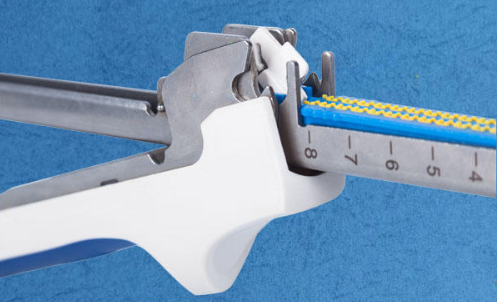Surgical staples are special staples used in surgery to replace sutures to close skin wounds or to connect or resect part of the intestine or lung.The use of staples on sutures reduces local inflammatory responses, wound width, and closure time.A more recent development, from the 1990s, is the use of clips instead of staples in some applications; this does not require staple penetration.
Uses of Linear Cutter Stapler
Instructions for use
Disposable linear cutting stapler places two staggered rows of double-row titanium staples,and cuts and divides tissue simultaneously between the two rows of double-rows.Disposable linear cutting staplers should not be used on tissues such as the liver or spleen,which may be crushed by instrument closure.

About Linear Cutter Stapler
The technique was pioneered by the Hungarian surgeon Hümér Hültl, the "father of surgical suturing". Hultl's prototype stapler in 1908 weighed 8 pounds (3.6 kg) and took two hours to assemble and load.The technique was refined in the Soviet Union in the 1950s, allowing the first commercially produced reusable suturing devices to be used to create bowel and vascular anastomoses.Ravitch brings a sample of the stapler after attending a surgical conference in the USSR and introduces it to entrepreneur Leon C. Hirsch, who founded Surgical America in 1964 to manufacture surgical sutures under his Auto Suture brand device.Until the late 1970s,USSC largely dominated the market,but in 1977 Johnson & Johnson's Ethicon brand entered the market, and today both brands are widely used along with competitors from the Far East. USSC was acquired by Tyco Healthcare in 1998 and changed its name to Covidien on June 29, 2007.The safety and patency of mechanical (anastomotic) bowel anastomosis have been extensively studied. In such studies,sutured anastomoses are usually comparable or less prone to leakage.This may be the result of recent advances in suture technology and increasingly risk-conscious surgical practices. Of course,modern synthetic sutures are more predictable and less susceptible to infection than the staple suture materials used before the 1990s—gut, silk, and linen.A key feature of intestinal staplers is that the edges of the stapler act as a hemostat, compressing the wound edges and closing the blood vessel during the stapling procedure. Recent studies have shown that using current suturing techniques, there is no significant difference in outcomes between manual suturing and mechanical anastomosis (including clips), but mechanical anastomosis is performed much faster.In patients whose lung tissue has been sealed with staplers for pneumonectomy, air leaks are common after surgery. Alternative techniques for sealing lung tissue are currently being investigated.
Types and Applications
The first commercial stapler was made of stainless steel with titanium staples packed in refillable staple cartridges.Modern surgical staplers are either disposable,made of plastic,or reusable,made of stainless steel. Both types are usually loaded with disposable cartridges.Staple lines can be straight,curved or round.Circular staplers are used for end-to-end anastomosis after bowel resection or, more controversially,esophagogastric surgery.These instruments can be used in open or laparoscopic procedures, with different instruments used for each application.Laparoscopic staplers are longer,thinner,and can be articulated to allow access from a limited number of trocar ports.Some staplers contain a knife that can cut and staple in one operation.Staplers are used to close internal and skin wounds.Skin staples are usually applied with a disposable stapler and removed with a specialized staple remover.Staplers are also used in the vertical band gastroplasty procedure (commonly known as "gastric stapling"). Although circular end-to-end anastomotic devices for the digestive tract are widely used,circular staplers for vascular anastomosis have never been compared to standard hand anastomosis despite intensive studies Make a big difference with (Carrel) suture techniques. Apart from the different way of connecting the vessel (eversioned) to the digestive (inverted) stump, the main underlying reason may be that,especially for small vessels,the manual work and precision required to position only the vessel stump and manipulate any device cannot be significantly less Performs the stitching required for standard hand stitching, so there's not much use in using any equipment.However, organ transplantation may be an exception where these two phases, device positioning at the vascular stump and device actuation,can be performed at different times by different surgical teams under safe conditions without the time required affecting Donor organ preservation, ie under cold ischemic conditions of the donor organ and the posterior table after resection of the recipient's natural organ.The goal of finalization is to minimize the dangerous warm ischemic phase of the donor organ, which can be contained in minutes or less, simply by attaching the end of the device and manipulating the stapler.While most surgical staples are made of titanium, stainless steel is more commonly used for some skin staples and clips.Titanium is less reactive with the immune system and, because it is a non-ferrous metal, does not significantly interfere with MRI scanners, although some imaging artifacts may occur.Synthetic absorbable (bioabsorbable) staples based on polyglycolic acid are now available, as are many synthetic absorbable sutures.
Removal of skin spikes
When skin staples are used to seal skin wounds, it is necessary to remove the staples after an appropriate healing period, usually 5 to 10 days,depending on the location of the wound and other factors.A skin spike remover is a small manual device consisting of a shoe or plate narrow and thin enough to be inserted under the skin spike.The moving part is a small blade that, when hand pressure is applied, pushes the staple down through a slot in the shoe, deforming the staple into an "M" shape for easier removal. In an emergency, the staples can be removed with a pair of arterial forceps.Skin staple removers are manufactured in a variety of shapes and forms,some are disposable and some are reusable.
Post time: Nov-18-2022





